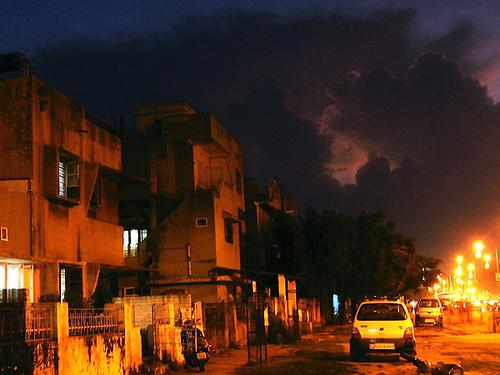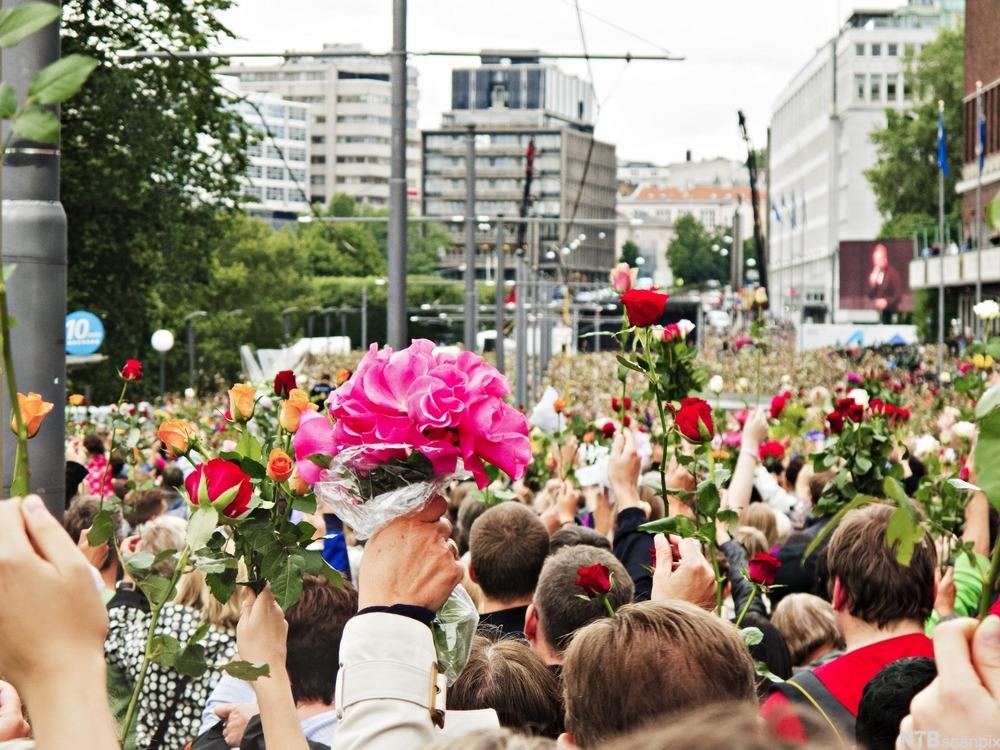
Discuss the following quote:
"Nonviolence is the answer to the crucial political and moral questions of our time; the need for mankind to overcome oppression and violence without resorting to oppression and violence. Mankind must evolve for all human conflict a method which rejects revenge, aggression, and retaliation. The foundation of such a method is love." (Martin Luther King Jr.)
- Explain what King means in your own words.
- Martin Luther King made the above statement when he was awarded the Nobel Peace Prize in 1964. Considering what has happened since then, why do you think it has been difficult to follow his recipe?
Definitions of Terrorism
There are several definitions of terrorism. Even though it may seem a bit confusing, this diversity is rather useful - it helps us formulate a set of important criteria that may help us identify this complex phenomenon.
- “the calculated use of unlawful violence or threat of unlawful violence to inculcate fear; intended to coerce or to intimidate governments or societies in the pursuit of goals that are generally political, religious, or ideological.” (US Department of Defense)
- "Terrorism is the unlawful use of force and violence against persons or property to intimidate or coerce a government, the civilian population, or any segment thereof, in furtherance of political or social objectives." (FBI)
- "premeditated politically-motivated violence perpetrated against non-combatant targets by sub-national groups or clandestine agents, usually intended to influence an audience" (U.S. Department of State)
- "An anxiety-inspiring method of repeated violent action, employed by (semi-) clandestine individual, group or state actors, for idiosyncratic, criminal or political reasons, whereby - in contrast to assassination - the direct targets of violence are not the main targets." (UN)
- "…the use of violence for political ends, and includes any use of violence for the purpose of putting the public, or any section of the public, in fear." (UK government)
- "the use of violence and threats to intimidate or coerce, especially for political purposes".
- "a terroristic method of governing or of resisting a government."
- "the systematic use of terror especially as a means of coercion"
- "the use of violent acts to frighten the people in an area as a way of trying to achieve a political goal "
- "the use of terror as a means of achieving a goal"
- "Common definitions of terrorism refer only to those violent acts which are intended to create fear (terror), are perpetrated for a religious, political or ideological goal, and deliberately target or disregard the safety of non-combatants (civilians).
[Sources - Terrorism Research (1-5), Dictionary Definition of Terrorism (dictionary.com) (6,7), Definition of Terrorism (merriam-webster) (8-10), Description of Terrorism (wikipedia)(11)]
Task
- Make a list of the elements present in terrorism based on the above definitions. Consider: purpose, method, motives, targets, by whom. What tactics do terrorists often use?
- Discuss why the definitions vary so much.
Suggested answers
Elements present in definitions of terrorism:
- Method: creating fear (through the use of violence – or the threat thereof).
- Purpose: retaliate, intimidate and coerce.
- Motives: agendas of a political, religious or ideological nature. In other words, terrorists come from very different horizons: over the last century, there has been right-wing and left wing terrorism, nationalist terrorists, Christian, Jewish and Muslim terrorists…
- Targets: quite diverse – whoever one wants to force to do certain things or strike with fear. However, a central trait of terrorism is that it's either indifferent when it comes to harming innocent bystanders or that it harms them intentionally in order to achieve their goals.
- Exercised by: individuals, groups and governments
- Tactics: bombing, hostage-taking and extortion, assassinations, armed attacks, torture and maiming, hijacking, hacking.
State Terrorism
There is a lot of focus on individuals and groups committing acts of terrorism. However, such strategies and tactics have also been used by states, for instance in the context of cultural revolutions – totalitarian attempts to homogenize the population ideologically (Examples: France during la Terreur, Stalinist USSR, China during Mao's Cultural Revolution, Cambodia under Pol Pot, etc.)
There are also cases where states find it in their interest to fund terrorist groups.
Resistance Movements and Freedom Fighters
There is no shortage of terrorist movements which claim that they merely and legitimately fight for freedom or resist oppression. Conversely, the word "terrorism" having such a negative connotation, it is often used rhetorically in order to discredit groups or individuals that one disagrees with. During the Second World War, for instance, the Norwegian resistance movement was qualified as terrorists by German propaganda.
Democracies Faced with Terrorism

Terrorism represents a dilemma for democratic societies. How should they react? In 2001, to protect America’s free, democratic society, George Bush chose to use America’s military might first in Afghanistan and later in Iraq to fight what he termed the Axis of Evil. He also introduced legislation which threatened the civil liberties of American citizens. In contrast, after Utøya, the Norwegian response has been openness and solidarity. As Prime Minister Jens Stoltenberg said on the first anniversary of the attacks in Norway, “The world has no better protection against terrorism than openness, democracy and humanity.” On the one hand, a democracy has to ensure its continued existence and to protect its inhabitants against aggression from without or within – if necessary by the use of force. On the other hand, they are defined by their commitment towards human dignity and the human rights that this belief entails. Terrorism may force them to choose between staying true to their ideals and using all means deemed necessary to fight attempts to harm their population and threaten their stability.
Counterterrorism Through International Cooperation
There are many ways to fight terrorism. Aiming at less hate and extremism at home and abroad, for example by education, debate and deserving the moral high ground, may be a good place to start. However, this will not always be enough, and in such situations one needs all the protection that the police and the intelligence community or, indeed, the armed forces are able to provide.
Since terrorism is a global phenomenon, it has been necessary to establish international cooperation in order to cope with it. Countries may work together case by case through the exchange of information, joint police or military operations, etc., may cooperate on the basis of formal bi- or multilateral agreements and may join forces by establishing and/or supporting international organizations.
Has Terrorism Ever Been an Efficient Means to an End?
The answer to this question depends upon which end one pursues. Indeed, if the goal is to create suffering and a cycle of violence, terrorism has been highly effective.
Gandhi once said: "I object to violence because when it appears to do good, the good is only temporary; the evil it does is permanent". Indeed, it is difficult to find examples of situations where terrorism has actually contributed to build anything. When the temptation to lash out, kill one's enemies, seek vengeance etc. is strong enough, some sort of satisfaction might result from giving in to it. However, this kind of gratification comes at a very high price: the day one is taken by the desire to reach for what one loves and wants instead of destroying what one hates, chances are that there are only ashes, dried blood and corpses left to build on.
Tasks and Activities
Discuss and Find Out
- Why is it so difficult to determine whether a movement should be considered a freedom movement or a terrorist movement? Which criteria do you consider to be the most important? Is it the sheer use of violence – be it sabotage, assassinations or less specifically aimed violent acts?
- During the Second World War, both sides in the conflict deliberately bombed civilian areas in Norway and other countries. Find out where such bombings took place and discuss whether this bombing, in order to seek vengeance or to lessen the population's will to fight, could be considered as state terrorism.
- Following 9/11, the CIA and the US Army developed "enhanced interrogation techniques". Find out what techniques were employed in order to force people who were being interrogated to reveal information.
Suggested Answers
waterboarding, sleep deprival, being kept naked and wet in a cold room, hard slaps on the abdomen or in the face, being kept for a long time in uncomfortable positions, dogs used to threaten, endless interrogations, being yelled at or shaken physically
- Look up the following keywords and find out what they are and how they are assosciated with terrorism: Guatanamo Bay Detention Center, Abu Ghraib, Bradley Manning and WikiLeaks.
- Read the following article: Waterboarding. How does the author support the claim that waterboarding is a form of torture?
- Many countries have passed new anti-terrorism legislation in recent years, e.g. in the UK Terrorism Acts. Find out which increased powers have been given to the police, the courts and the government.
- The introduction of anti-terror laws always creates discussion because they may come into conflict with democratic principles and the rights of the individual. Norwegian anti-terror laws are relatively moderate compared to some other countries. Read this article from February 2012, Anti-Terror Laws in Norway. Do you agree with the author? What type of anti-terror laws do you deem necessary.
The UN and Counterterrorism
Browse through the web pages that are dedicated to the UN's counterterrorist action UN Action to Counter Terrorism and find out what the UN does in order to fight terrorism? Take notes and share what you found with fellow students.
Prefixes – Interactive Task
Writing/Presentation
- Write an essay about one resistance group or individual freedom fighter. Include information about their background, ideals, purpose, motives, methods and present your arguments for the individual/group being a freedom fighter rather than a terrorist. This task could also be done as a multimedia presentation.